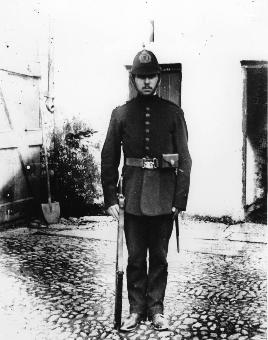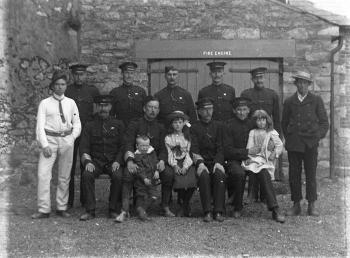 The R.I.C. of Dungarvan resided, prior to 1873, and after that date, in premises in Blackpool, now O'Connell Street, where they had their lock-up and a spacious yard. There was also a police barracks in Abbeyside at the same time which used to keep four men. Their station was in one of the houses facing the river Colligan, and the combined forces of the Abbeyside and Dungarvan police were some twenty men. The Abbeyside station was given up, and the Dungarvan police had charge of the entire district.
The R.I.C. of Dungarvan resided, prior to 1873, and after that date, in premises in Blackpool, now O'Connell Street, where they had their lock-up and a spacious yard. There was also a police barracks in Abbeyside at the same time which used to keep four men. Their station was in one of the houses facing the river Colligan, and the combined forces of the Abbeyside and Dungarvan police were some twenty men. The Abbeyside station was given up, and the Dungarvan police had charge of the entire district. The force in Dungarvan consisted of a District Inspector, Head Constable, two or more sergeants, and the subs. The District Inspector had charge of all the stations in the surrounding country districts. Subsequently the Dungarvan police left their premises in Blackpool and took up their quarters in a large house in the corner of Grattan Square. It had previously been known as "Flynn's Hotel". The R.I.C. continued residing there for over a dozen years, when they were transferred to King John's Castle, and there they remained for the entire time until the coming of the evacuation and dispersal of British forces in Ireland, as a result of the Treaty arranged between Ireland and England in 1921. (edited extract from Keohan's History Of Dungarvan).
General history of the R.I.C in Ireland
The foundation of the R.I.C. dates from 1836 when Thomas Drummond, under-secretary for Ireland from 1835-40 passed an "act consolidating the laws relating to the Constabulary Force in Ireland". Drummond had some noble intentions when passing this law, he wished to eliminate the influence of local landlords (and the Orange Lodge in Northern Ireland) from police matters. He also wished to make the force acceptable to Catholics by allowing them to join it as officers and constables. This policy initially appeared to work as between 1836 and 1847 complaints against the police force were much rarer than in previous decades. Drummond also intended that the force would ensure the continuation of British rule in Ireland. The force had a strength of 10,000 at its foundation rising to 10,500 in 1856.
Policemen were generally much better educated than the local population as a whole and were expected to maintain a position of importance and high standing in their community.
Instructions were laid down in police regulations to help maintain the expected standard of behaviour. Policemen were forbidden to marry until after seven years service, in order that a sufficient amount of wealth would be accumulated to allow them to live comfortably, while supporting a family. The bride was vetted for suitability. Many trades were forbidden to the policeman and his spouse and they were prevented from selling goods or keeping lodgers.
During the early years of this century until the Easter rising in Dublin in 1916 the duties of the R.I.C. were less than exacting, much of their non-routine duties were concerning isolated agrarian disputes. By 1913, 86% of recruits were Catholic and although the officer class was still Protestant in the majority, by 1920 the number of Catholics at officer level had risen to 40% and the force had its first Catholic Inspector General (overall commander).
 From the photos it is plain that the R.I.C. had a military aspect to them, "The Memoirs Of Constable Jeremiah Mee, R.I.C." provide an insight into why this was the case.
From the photos it is plain that the R.I.C. had a military aspect to them, "The Memoirs Of Constable Jeremiah Mee, R.I.C." provide an insight into why this was the case.
"The Irish police force, as structured by Thomas Drummond, for a long time realised one of its main aims, namely, that of ensuring the continuation of British rule in Ireland. It's semi-military character, which arose from the way in which it was armed (with carbines and swords), officered (most of its supervisory staff spent some time in the regular army), and housed (its barracks were described with some justification as 'the block-houses of Imperial rule in Ireland'), grew, in a sense, out of the kind of work which it was expected to do. Thus the Irish Constabulary bore the brunt of the Tithe War, the Young Ireland threat, the Fenian Rising and the Land War. The force acquired the designation 'Royal' from Queen Victoria in 1867 in recognition of its services in the suppression of the Fenian Rising.
This information for this chapter was derived from "The Royal Irish Constabulary: An Oral History" by John D. Brewer (1990) and the "Memoirs Of Constable Jeremiah Mee, R.I.C." Any extracts are copyright of their respective authors.